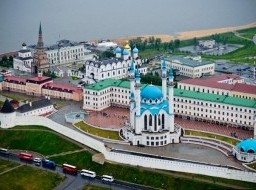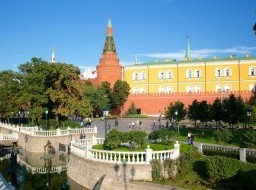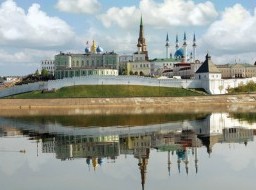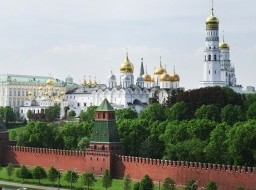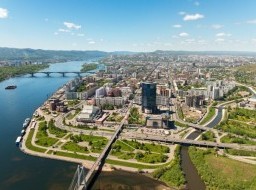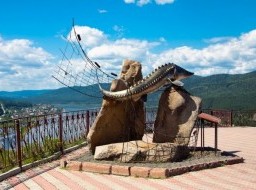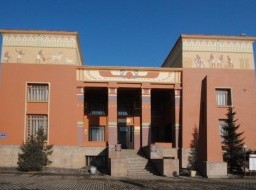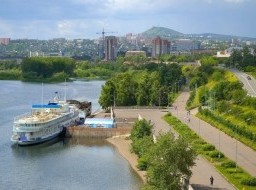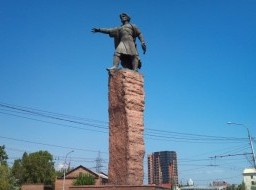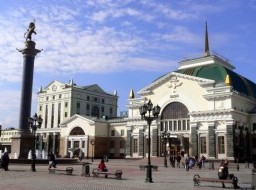Krasnoyarsk
Krasnoyarsk is a wonderful Russian city in the center of Siberia. More orderly and affluent than the average Siberian city, million-strong Krasnoyarsk enjoys an appealing setting amid low beautiful hills punctuated by jagged rock formations. Unique landscapes, mountains, mighty Siberian woods and the well-known reserve "Stolby" (Pillars), inscribed on the UNESCO World Heritage List. This creation of the nature represents exotic rocky eminences among taiga in spurs of the East Sayan mountains. Pleasant river trips and an outstanding regional museum make Krasnoyarsk an agreeable place to break the long journey. Its architecture is particularly inspiring. Krasnoyarsk is the centre of the vast Krasnoyarsk region, the second biggest city in Siberia. It lies along the Yenisey River — one of the most beautiful and powerful Russian rivers, which divides Siberia into eastern and western part. Krasnoyarsk is the top touristic destination, it's worth visiting, especially if you travel along the Trans-Siberian route or you want to explore the stunning nature of the central Siberia. Russian czars started developing the boundless space of the “wild east” lying beyond the Urals (mountains between European and Asian parts of Russia) in the fifteenth and sixteenth centuries. Constant threat of attack to Russian lands in near-Yenisey Siberia was the initial reason for the appearance of Krasnoyarsk. The history of Krasnoyarsk counts back to the year 1628 when it was founded as a Russian border fort by the Cossack Andrey Dubensky. The fort had been named «Krasny Yar» (Красный Яр) after the local Turkic name of the place, meaning «Red Cliff» or «Krasny Yar» in Old Russian. The name «Krasnoyarsk» was later given when the village of Krasny Yar had received town status. This fabulous fort became an outpost for almost one hundred years. In those days, it was a wooden castle surrounded by a ditch, a wall and five towers. Every year, Krasnoyarsk was under attacks from the raiders coming from south. Sometimes Cossacks had to withstand a siege for months, but to this date an enemy has never conquered the town. It received town status in 1690, when Siberia was finally united with Russia. In those days, there were only about 2,500 people living in Krasnoyarsk, and mostly males. But the picture totally changed during the next 20 years. According to a census dating from 1713, the number of males and females was almost the same. Krasnoyarsk, the former military settlement, was becoming a town. At that time it used to be a local center and was an important transport hub for river transport (the Yenisey River goes up to the North Ocean). The Trans-Siberian motorway going through Krasnoyarsk gave a boost to industrial development of the city, especially metal production, oil, and construction industries. A new stage of development started in 1822 when the Yenisey’s gubernia (province) was created. Being in a most profitable location, the city was chosen to be an administrative center. With the appearance of new state institutions and government offices, life in Krasnoyarsk changed dramatically. A telegraph station, an elementary school, male and female gymnasiums, a teacher’s seminary and a community college opened. Krasnoyarsk became an attractive destination for business people, laborers and gold miners. The first stone buildings were built at the same time. The city park was established as well. The first newspaper was published. The building of the Trans-Siberian Railroad further increased the development of the city. On December 6th of 1895 the first train arrived in Krasnoyarsk. The provincial mercantile/governmental outpost image of Krasnoyarsk was changing into the image of a big trade and industrial center. The city could not avoid taking part in the events of the Revolution of 1917 and then Russian drama of Civil War of 1920s. Been located on the midway of the Trans-Siberian railroad it was the strategic point for both sides – Reds and Whites. In 30s of 20th century the city got involved into the rapid Soviet industrialization. The upcoming WWII stimulated the Krasnoyarsk’s economy even more, turning it into very industrial city. Since 1934, Krasnoyarsk has been the administrative center of the Krasnoyarski krai (Krasnoyarsk region) with its increasing level of development of different industries. During WWII, the number of industries in Krasnoyarsk had grown sevenfold compared to pre-WWII times. The WWII is also significant to the region as the most eastern battle with Nazis took place on the territory of the Krasnoyarsk region. In August of 1942 the German warship attacked the port Dixon on the Kara sea shore. After WWII Krasnoyarsk became a big center for scientific researches as well as high and middle levels of education. Krasnoyarsk is distinguished by its unique landscapes, mountain views, majestic Siberian forest and well-known Stolby Nature Reserve. The territory of the reserve totals 47 000 hectares. Today’s Krasnoyarsk is a modern industrial city with unique architecture, a capital of artistic and talented people of Siberia and one of the most beautiful cities in the country. Several years in succession, Krasnoyarsk has been recognized as one of the most ‘comfortable’ cities in Russia. A number of various projects and programs, directed to the improvement of urban environment, are realized in Krasnoyarsk. In the 1960’s, Krasnoyarsk became a major transport junction. Three of the most important transport routes, the Trans-Siberian railway, a highway of federal significance and the river Yenisei pass through the city. Krasnoyarsk is well known in Russia for its Paraskeva Pyatnitsa Chapel, for an architectural ensemble of office buildings on Karl Marks street, as well as for its Clock Tower. Krasnoyarsk bridges are among the main sights of the city. The Railway Bridge over the Yenisei, constructed in 1899 by mechanical engineer E.K. Knorre as part of the project by known Russian engineer L.D. Proskuryakov, was awarded with gold medal at the World Fair in Paris in 1900 as the highest achievement of technical idea. Communal Bridge is one of the symbols of the city. In 2003, a new symbol, the Historical Gates to the City, appeared in Krasnoyarsk. They were constructed at the exact place, where almost four centuries ago the settlement’s history began. In year of the 375th Anniversary of Krasnoyarsk, another tradition appeared – a carnival, which became one of the main events of City Day. The carnival procession annually includes over 10 000 people. Krasnoyarsk is the city famous for its remarkable people and a unique history. It is a city, which every day enters bright and significant pages of its life into the annals of history. |

